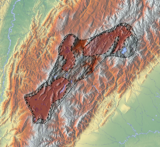| Sugamuxi | |
|---|---|
| Iraca | |
 Statue of Sugamuxi in the Archeological Museum of Sogamoso | |
| Reign | –1539 |
| Predecessor | Nompanim |
| Successor | Position abolished |
| Born | unknown Suamox, Muisca Confederation |
| Died | 1539 Sogamoso, New Kingdom of Granada |
Sugamuxi (died 1539) was the last iraca ; cacique of the sacred City of the Sun Suamox. Sugamuxi, presently called Sogamoso, was an important city in the religion of the Muisca who inhabited the Altiplano Cundiboyacense in the times before the Spanish conquistadors reached the central highlands of the Colombian Andes. Fellow Muisca rulers of other territories within the Muisca Confederation were Tundama in Tundama, zaque Aquiminzaque in Hunza and zipa Sagipa in Bacatá.











